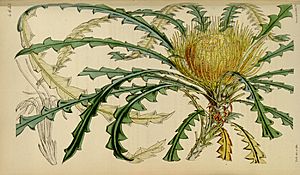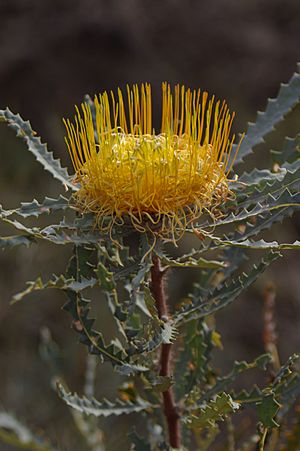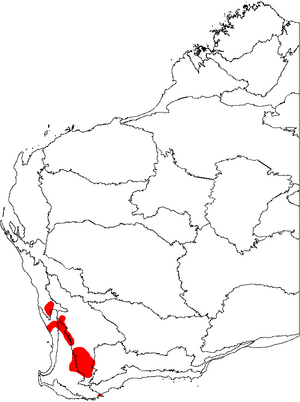Golden dryandra facts for kids
Quick facts for kids Golden dryandra |
|
|---|---|
 |
|
| Plate 4633 of Curtis's Botanical Magazine by Walter Hood Fitch | |
| Scientific classification | |
| Genus: |
Banksia
|
| Species: |
nobilis
|
| Synonyms | |
|
Dryandra nobilis Lindl. |
|
Banksia nobilis, often called the golden dryandra, great dryandra, or kerosene bush, is a type of shrub. It belongs to the Proteaceae plant family. This plant grows naturally only in Western Australia. You can find it on rocky, iron-rich hills (called lateritic rises). Its range stretches from Eneabba in the north to Katanning in the south.
This plant has large leaves with triangle-shaped parts. Its flowers are a beautiful golden or reddish-pink color. Because of its striking look, it is a popular plant for gardens. Until 2007, it was known as Dryandra nobilis. Then, all Dryandra species were moved into the Banksia group by scientists Austin Mast and Kevin Thiele. There are two main types, or subspecies, of this plant: B. nobilis subsp. nobilis and B. nobilis subsp. fragrans.
Contents
What Does Golden Dryandra Look Like?
Banksia nobilis grows as a shrub and can reach up to four meters (about 13 feet) tall. Its leaves are long and have many deep cuts. Each leaf can be eight to 22 centimeters (about 3 to 8.5 inches) long. They are five to 25 millimeters (about 0.2 to 1 inch) wide. Each side of the leaf has 14 to 32 triangle-shaped parts.
The plant produces many flowers. These flower clusters, called inflorescences, grow on short side branches. You can often see a flower cluster in almost every leaf joint. The flowers are golden or reddish-pink. They have a greenish-cream tip. After the plant flowers, each flower head can produce up to five seed pods, called follicles.
The Story Behind Its Name
The first samples of Banksia nobilis were collected in the 1830s. This was done by James Drummond near the Swan River Colony in Western Australia. The plant was officially named Dryandra nobilis by John Lindley in 1840. He wrote about it in his book, A Sketch of the Vegetation of the Swan River Colony. Lindley described it as a "most splendid plant" because of its long leaves.
The name nobilis comes from the Latin word for "noble" or "imposing." This name was likely chosen because of the plant's grand and impressive appearance.
In 2007, a big change happened in how plants are classified. Scientists Austin Mast and Kevin Thiele moved all species from the Dryandra group into the Banksia group. This is why the plant's name changed from Dryandra nobilis to its current name, Banksia nobilis.
Where Golden Dryandra Grows
Banksia nobilis grows on rocky, iron-rich hills. Its range goes from Eneabba in the north to Katanning in the south. Much of where it grows follows the edge between two natural areas: the Jarrah Forest and the Avon Wheatbelt. However, in the north, it also reaches into the Swan Coastal Plain and Geraldton Sandplains.
For most of its range, it grows in eucalypt woodlands. These are forests with eucalyptus trees. It also grows in tall shrublands, which are areas with many shrubs. In its northern parts, it can be found among thick kwongan, a type of dense shrubland.
Protecting Golden Dryandra
The subspecies Banksia nobilis subsp. nobilis is not currently considered endangered. In fact, it is sometimes harvested from the wild for the cut flower industry.
However, the other subspecies, Banksia nobilis subsp. fragrans, is listed as "Priority Three - Poorly Known Taxa." This means that the Western Australian Department of Environment and Conservation knows about it, but not enough is known to say if it's truly endangered. More research is needed.
Scientists have also looked at how climate change might affect this plant. They found that if climate change is very severe, the area where this plant can grow might shrink by up to 80% by the year 2080. But if climate change is less severe, its distribution might only shrink a little, or it could even grow if the plant can move into new suitable areas.
Growing Golden Dryandra in Your Garden
Banksia nobilis subsp. nobilis has been a popular garden plant for a long time. People love it because it produces so many flowers.
This plant prefers soil that is heavy and gravelly. It needs soil that drains water very well. It also likes a sunny spot in the garden. It can handle dry periods (drought tolerant) and can survive frost down to -7 °C (19 °F). As the plants get older, they can become a bit messy. So, it's a good idea to prune them when they are young to keep them neat.
You can grow this plant from seed. It's hard to grow new plants from stem cuttings because the stems are hairy. Heel cuttings (a type of cutting with a bit of older wood) have had some limited success. Seeds usually sprout in three to four weeks, and many of them grow successfully. The plant typically starts to flower when it is three to four years old from seed.
Banksia nobilis subsp. fragrans is newer to cultivation, so there isn't much information about growing it yet. It probably needs similar conditions to subspecies nobilis. However, it might do better in warmer areas.



